Innovation and Creativity in Organizational Settings
VerifiedAdded on 2023/06/13
|14
|3720
|158
AI Summary
This article discusses the theory and practice of creativity and innovation in an organizational setting. It explores key factors towards successful innovations and provides examples of organizations whose success is based on innovation. The article also covers the concepts of creativity, innovation, and entrepreneurship and their roles in organizational success.
Contribute Materials
Your contribution can guide someone’s learning journey. Share your
documents today.
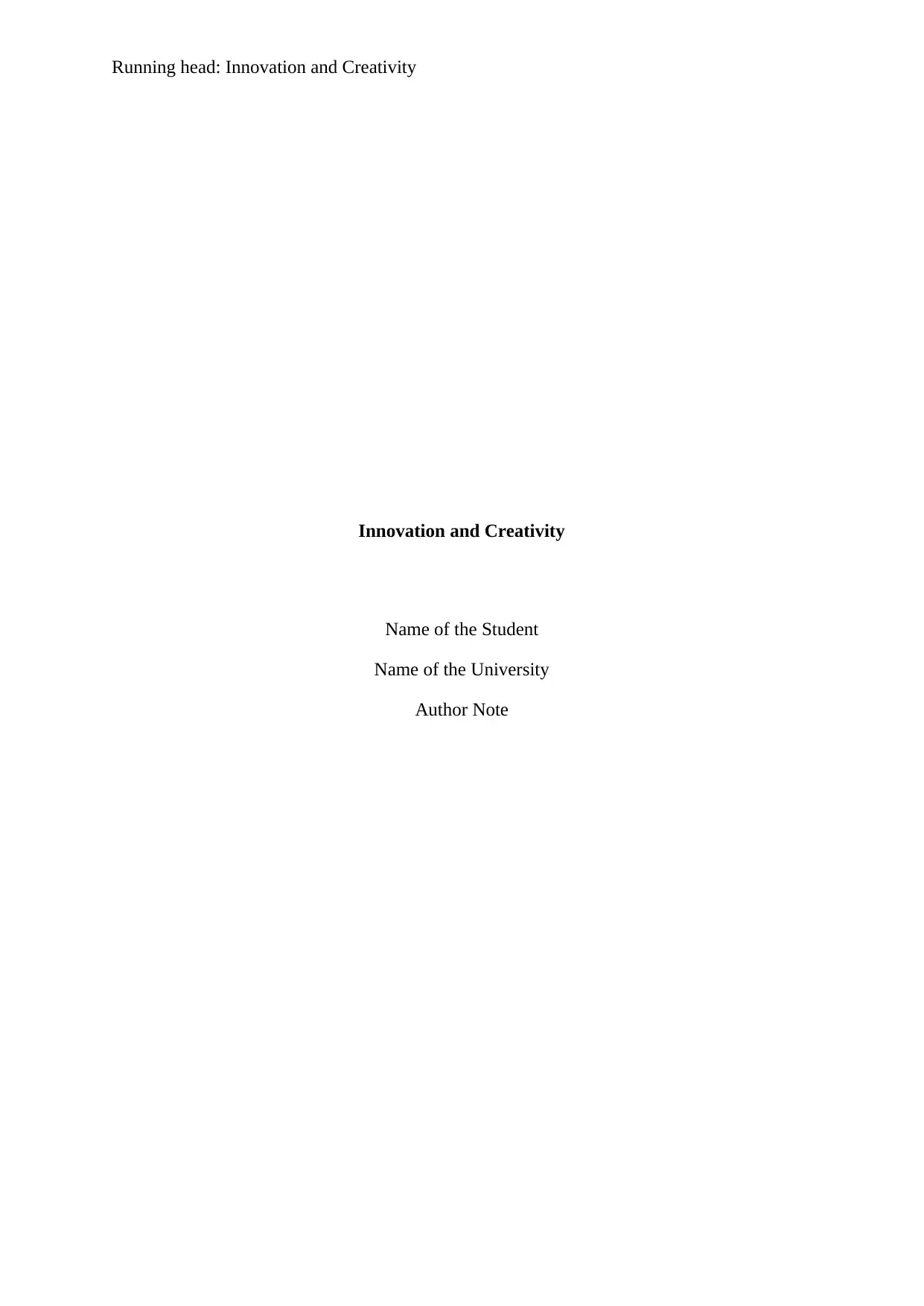
Running head: Innovation and Creativity
Innovation and Creativity
Name of the Student
Name of the University
Author Note
Innovation and Creativity
Name of the Student
Name of the University
Author Note
Secure Best Marks with AI Grader
Need help grading? Try our AI Grader for instant feedback on your assignments.
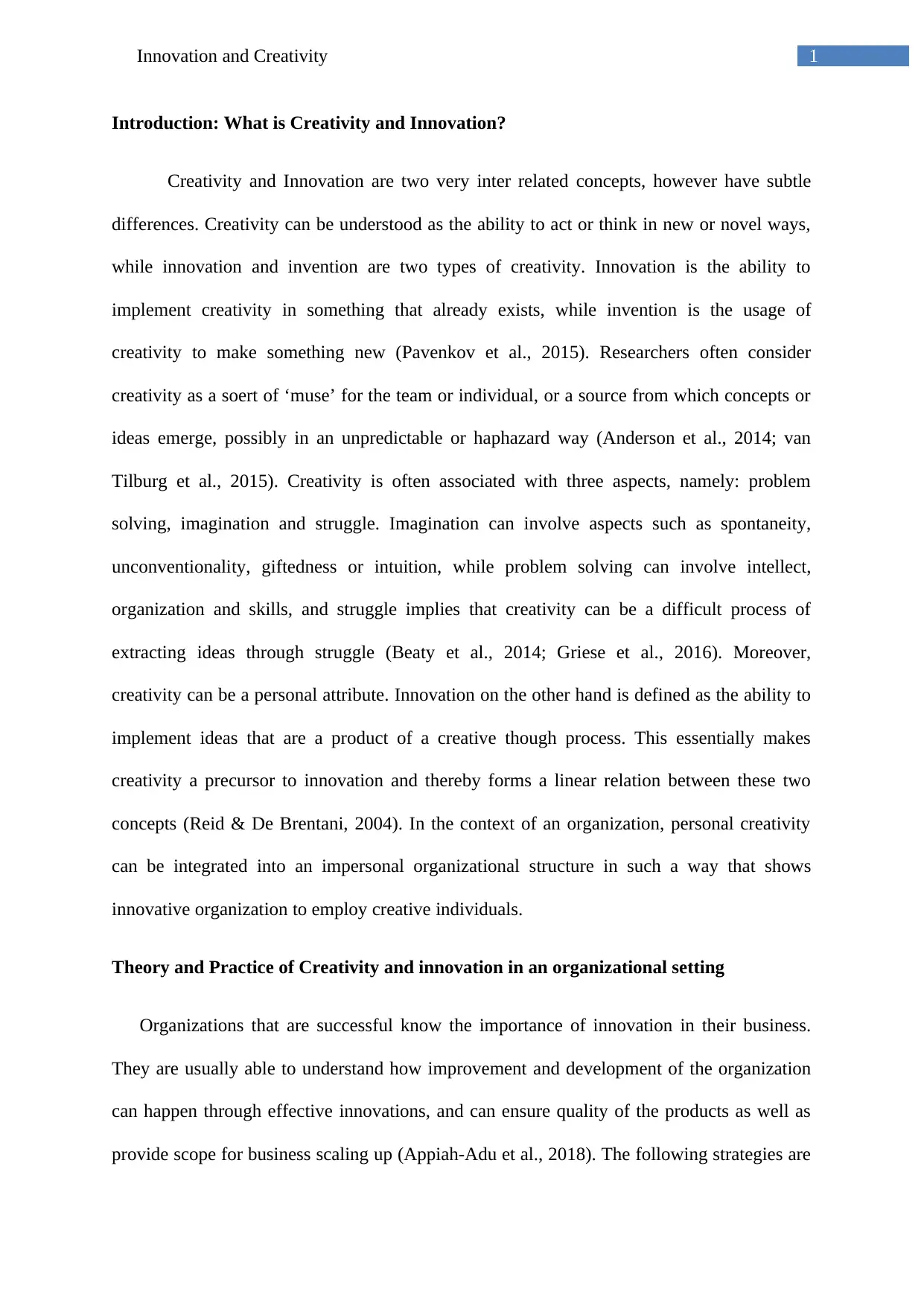
1Innovation and Creativity
Introduction: What is Creativity and Innovation?
Creativity and Innovation are two very inter related concepts, however have subtle
differences. Creativity can be understood as the ability to act or think in new or novel ways,
while innovation and invention are two types of creativity. Innovation is the ability to
implement creativity in something that already exists, while invention is the usage of
creativity to make something new (Pavenkov et al., 2015). Researchers often consider
creativity as a soert of ‘muse’ for the team or individual, or a source from which concepts or
ideas emerge, possibly in an unpredictable or haphazard way (Anderson et al., 2014; van
Tilburg et al., 2015). Creativity is often associated with three aspects, namely: problem
solving, imagination and struggle. Imagination can involve aspects such as spontaneity,
unconventionality, giftedness or intuition, while problem solving can involve intellect,
organization and skills, and struggle implies that creativity can be a difficult process of
extracting ideas through struggle (Beaty et al., 2014; Griese et al., 2016). Moreover,
creativity can be a personal attribute. Innovation on the other hand is defined as the ability to
implement ideas that are a product of a creative though process. This essentially makes
creativity a precursor to innovation and thereby forms a linear relation between these two
concepts (Reid & De Brentani, 2004). In the context of an organization, personal creativity
can be integrated into an impersonal organizational structure in such a way that shows
innovative organization to employ creative individuals.
Theory and Practice of Creativity and innovation in an organizational setting
Organizations that are successful know the importance of innovation in their business.
They are usually able to understand how improvement and development of the organization
can happen through effective innovations, and can ensure quality of the products as well as
provide scope for business scaling up (Appiah-Adu et al., 2018). The following strategies are
Introduction: What is Creativity and Innovation?
Creativity and Innovation are two very inter related concepts, however have subtle
differences. Creativity can be understood as the ability to act or think in new or novel ways,
while innovation and invention are two types of creativity. Innovation is the ability to
implement creativity in something that already exists, while invention is the usage of
creativity to make something new (Pavenkov et al., 2015). Researchers often consider
creativity as a soert of ‘muse’ for the team or individual, or a source from which concepts or
ideas emerge, possibly in an unpredictable or haphazard way (Anderson et al., 2014; van
Tilburg et al., 2015). Creativity is often associated with three aspects, namely: problem
solving, imagination and struggle. Imagination can involve aspects such as spontaneity,
unconventionality, giftedness or intuition, while problem solving can involve intellect,
organization and skills, and struggle implies that creativity can be a difficult process of
extracting ideas through struggle (Beaty et al., 2014; Griese et al., 2016). Moreover,
creativity can be a personal attribute. Innovation on the other hand is defined as the ability to
implement ideas that are a product of a creative though process. This essentially makes
creativity a precursor to innovation and thereby forms a linear relation between these two
concepts (Reid & De Brentani, 2004). In the context of an organization, personal creativity
can be integrated into an impersonal organizational structure in such a way that shows
innovative organization to employ creative individuals.
Theory and Practice of Creativity and innovation in an organizational setting
Organizations that are successful know the importance of innovation in their business.
They are usually able to understand how improvement and development of the organization
can happen through effective innovations, and can ensure quality of the products as well as
provide scope for business scaling up (Appiah-Adu et al., 2018). The following strategies are
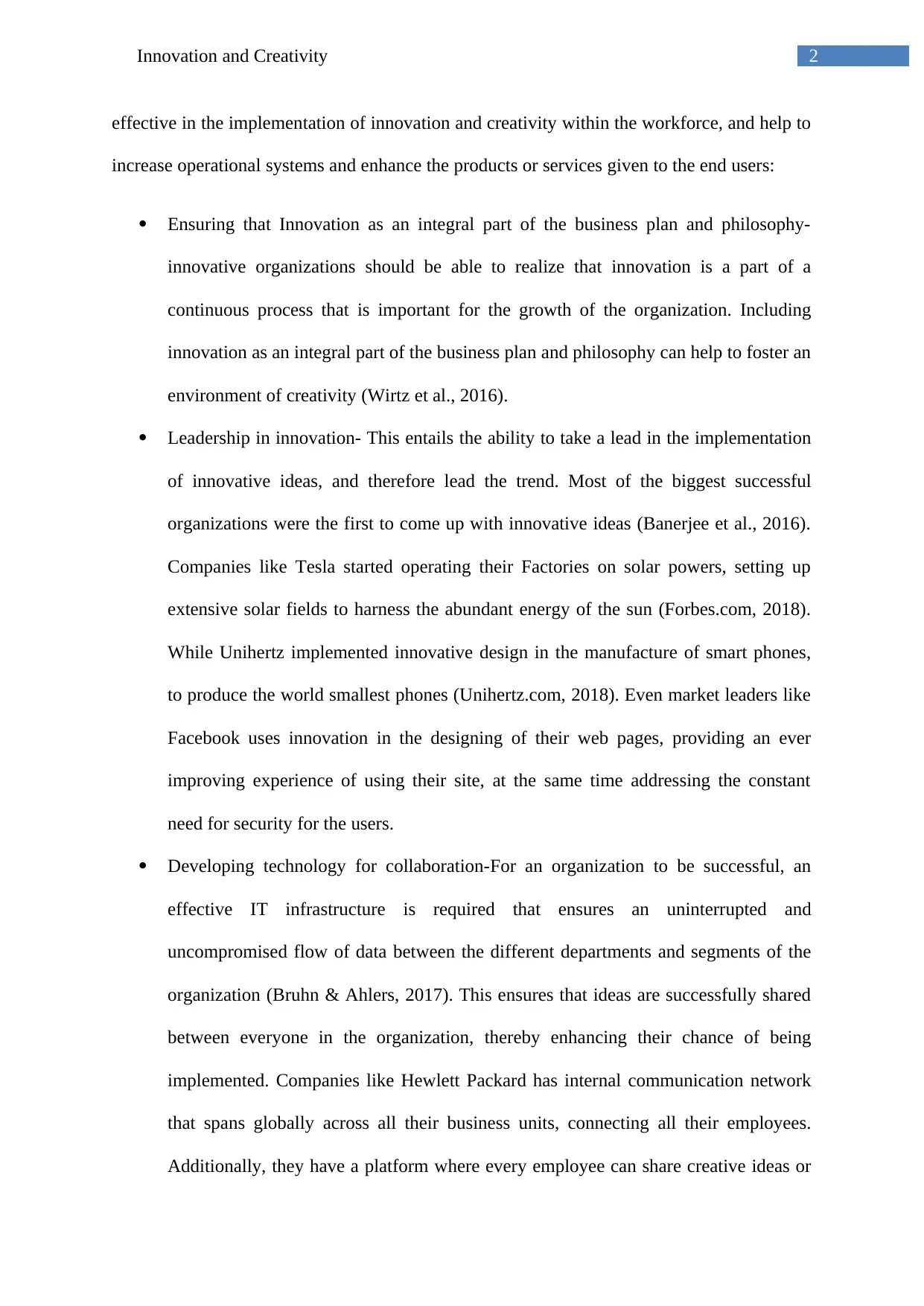
2Innovation and Creativity
effective in the implementation of innovation and creativity within the workforce, and help to
increase operational systems and enhance the products or services given to the end users:
Ensuring that Innovation as an integral part of the business plan and philosophy-
innovative organizations should be able to realize that innovation is a part of a
continuous process that is important for the growth of the organization. Including
innovation as an integral part of the business plan and philosophy can help to foster an
environment of creativity (Wirtz et al., 2016).
Leadership in innovation- This entails the ability to take a lead in the implementation
of innovative ideas, and therefore lead the trend. Most of the biggest successful
organizations were the first to come up with innovative ideas (Banerjee et al., 2016).
Companies like Tesla started operating their Factories on solar powers, setting up
extensive solar fields to harness the abundant energy of the sun (Forbes.com, 2018).
While Unihertz implemented innovative design in the manufacture of smart phones,
to produce the world smallest phones (Unihertz.com, 2018). Even market leaders like
Facebook uses innovation in the designing of their web pages, providing an ever
improving experience of using their site, at the same time addressing the constant
need for security for the users.
Developing technology for collaboration-For an organization to be successful, an
effective IT infrastructure is required that ensures an uninterrupted and
uncompromised flow of data between the different departments and segments of the
organization (Bruhn & Ahlers, 2017). This ensures that ideas are successfully shared
between everyone in the organization, thereby enhancing their chance of being
implemented. Companies like Hewlett Packard has internal communication network
that spans globally across all their business units, connecting all their employees.
Additionally, they have a platform where every employee can share creative ideas or
effective in the implementation of innovation and creativity within the workforce, and help to
increase operational systems and enhance the products or services given to the end users:
Ensuring that Innovation as an integral part of the business plan and philosophy-
innovative organizations should be able to realize that innovation is a part of a
continuous process that is important for the growth of the organization. Including
innovation as an integral part of the business plan and philosophy can help to foster an
environment of creativity (Wirtz et al., 2016).
Leadership in innovation- This entails the ability to take a lead in the implementation
of innovative ideas, and therefore lead the trend. Most of the biggest successful
organizations were the first to come up with innovative ideas (Banerjee et al., 2016).
Companies like Tesla started operating their Factories on solar powers, setting up
extensive solar fields to harness the abundant energy of the sun (Forbes.com, 2018).
While Unihertz implemented innovative design in the manufacture of smart phones,
to produce the world smallest phones (Unihertz.com, 2018). Even market leaders like
Facebook uses innovation in the designing of their web pages, providing an ever
improving experience of using their site, at the same time addressing the constant
need for security for the users.
Developing technology for collaboration-For an organization to be successful, an
effective IT infrastructure is required that ensures an uninterrupted and
uncompromised flow of data between the different departments and segments of the
organization (Bruhn & Ahlers, 2017). This ensures that ideas are successfully shared
between everyone in the organization, thereby enhancing their chance of being
implemented. Companies like Hewlett Packard has internal communication network
that spans globally across all their business units, connecting all their employees.
Additionally, they have a platform where every employee can share creative ideas or
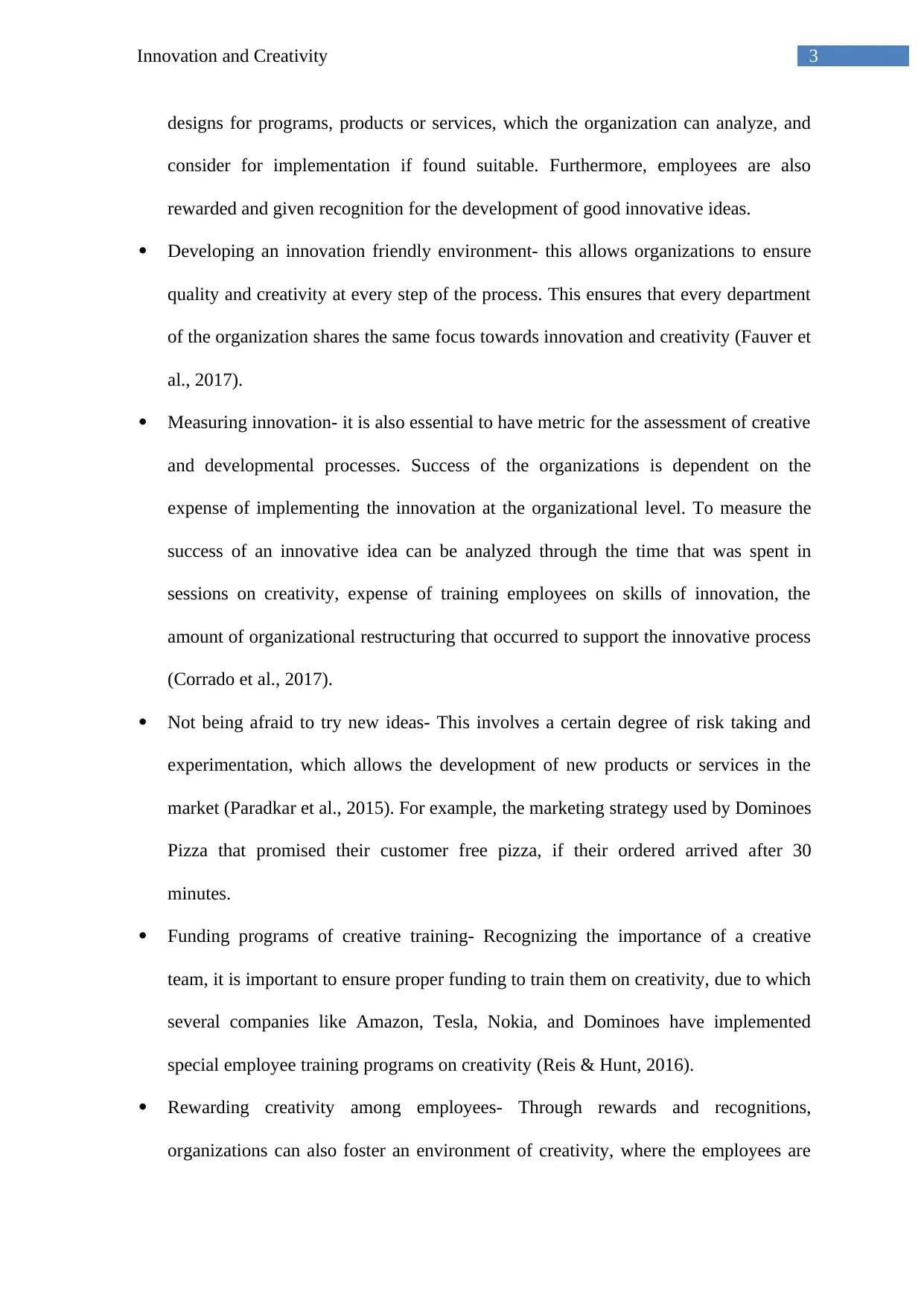
3Innovation and Creativity
designs for programs, products or services, which the organization can analyze, and
consider for implementation if found suitable. Furthermore, employees are also
rewarded and given recognition for the development of good innovative ideas.
Developing an innovation friendly environment- this allows organizations to ensure
quality and creativity at every step of the process. This ensures that every department
of the organization shares the same focus towards innovation and creativity (Fauver et
al., 2017).
Measuring innovation- it is also essential to have metric for the assessment of creative
and developmental processes. Success of the organizations is dependent on the
expense of implementing the innovation at the organizational level. To measure the
success of an innovative idea can be analyzed through the time that was spent in
sessions on creativity, expense of training employees on skills of innovation, the
amount of organizational restructuring that occurred to support the innovative process
(Corrado et al., 2017).
Not being afraid to try new ideas- This involves a certain degree of risk taking and
experimentation, which allows the development of new products or services in the
market (Paradkar et al., 2015). For example, the marketing strategy used by Dominoes
Pizza that promised their customer free pizza, if their ordered arrived after 30
minutes.
Funding programs of creative training- Recognizing the importance of a creative
team, it is important to ensure proper funding to train them on creativity, due to which
several companies like Amazon, Tesla, Nokia, and Dominoes have implemented
special employee training programs on creativity (Reis & Hunt, 2016).
Rewarding creativity among employees- Through rewards and recognitions,
organizations can also foster an environment of creativity, where the employees are
designs for programs, products or services, which the organization can analyze, and
consider for implementation if found suitable. Furthermore, employees are also
rewarded and given recognition for the development of good innovative ideas.
Developing an innovation friendly environment- this allows organizations to ensure
quality and creativity at every step of the process. This ensures that every department
of the organization shares the same focus towards innovation and creativity (Fauver et
al., 2017).
Measuring innovation- it is also essential to have metric for the assessment of creative
and developmental processes. Success of the organizations is dependent on the
expense of implementing the innovation at the organizational level. To measure the
success of an innovative idea can be analyzed through the time that was spent in
sessions on creativity, expense of training employees on skills of innovation, the
amount of organizational restructuring that occurred to support the innovative process
(Corrado et al., 2017).
Not being afraid to try new ideas- This involves a certain degree of risk taking and
experimentation, which allows the development of new products or services in the
market (Paradkar et al., 2015). For example, the marketing strategy used by Dominoes
Pizza that promised their customer free pizza, if their ordered arrived after 30
minutes.
Funding programs of creative training- Recognizing the importance of a creative
team, it is important to ensure proper funding to train them on creativity, due to which
several companies like Amazon, Tesla, Nokia, and Dominoes have implemented
special employee training programs on creativity (Reis & Hunt, 2016).
Rewarding creativity among employees- Through rewards and recognitions,
organizations can also foster an environment of creativity, where the employees are
Secure Best Marks with AI Grader
Need help grading? Try our AI Grader for instant feedback on your assignments.
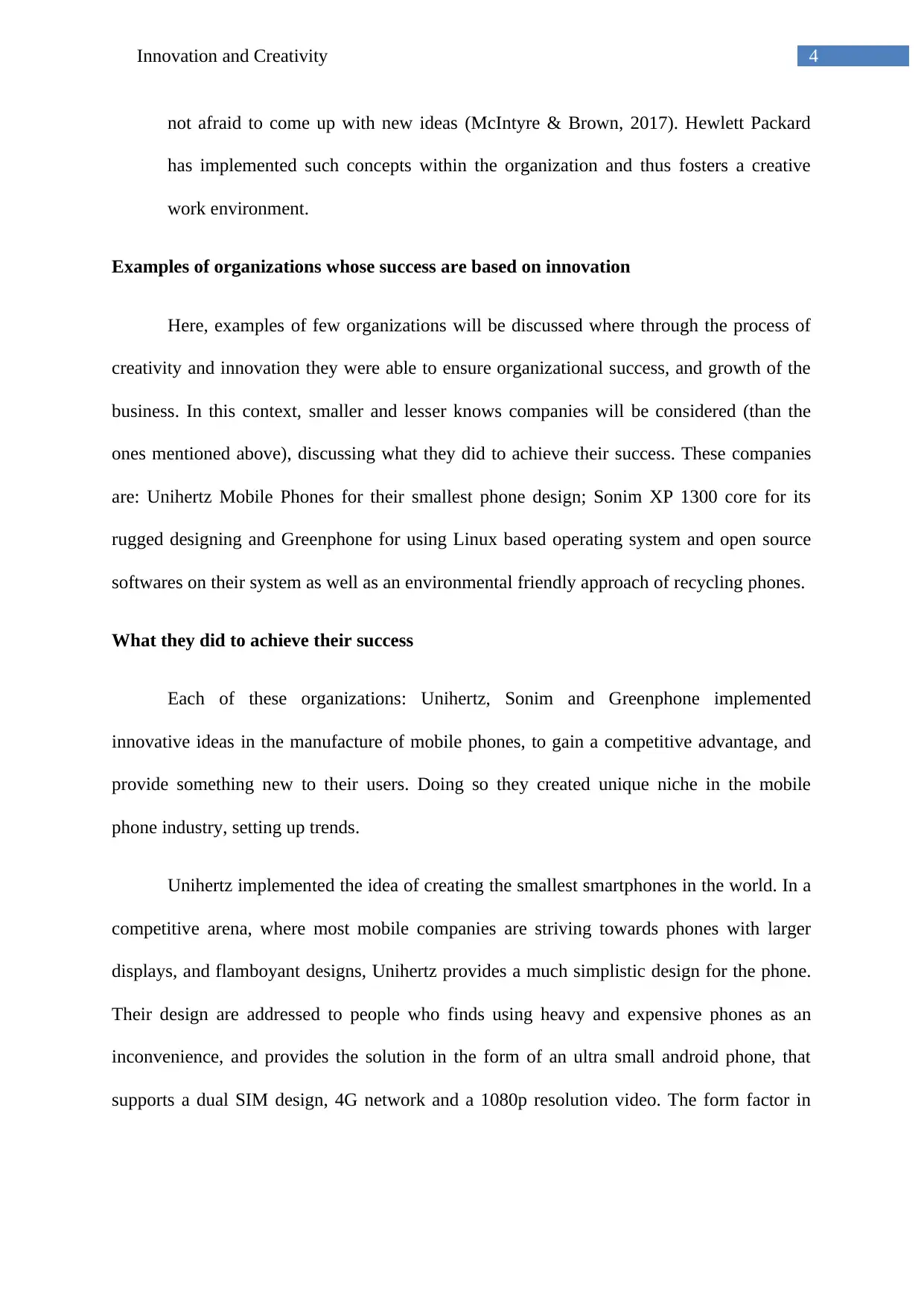
4Innovation and Creativity
not afraid to come up with new ideas (McIntyre & Brown, 2017). Hewlett Packard
has implemented such concepts within the organization and thus fosters a creative
work environment.
Examples of organizations whose success are based on innovation
Here, examples of few organizations will be discussed where through the process of
creativity and innovation they were able to ensure organizational success, and growth of the
business. In this context, smaller and lesser knows companies will be considered (than the
ones mentioned above), discussing what they did to achieve their success. These companies
are: Unihertz Mobile Phones for their smallest phone design; Sonim XP 1300 core for its
rugged designing and Greenphone for using Linux based operating system and open source
softwares on their system as well as an environmental friendly approach of recycling phones.
What they did to achieve their success
Each of these organizations: Unihertz, Sonim and Greenphone implemented
innovative ideas in the manufacture of mobile phones, to gain a competitive advantage, and
provide something new to their users. Doing so they created unique niche in the mobile
phone industry, setting up trends.
Unihertz implemented the idea of creating the smallest smartphones in the world. In a
competitive arena, where most mobile companies are striving towards phones with larger
displays, and flamboyant designs, Unihertz provides a much simplistic design for the phone.
Their design are addressed to people who finds using heavy and expensive phones as an
inconvenience, and provides the solution in the form of an ultra small android phone, that
supports a dual SIM design, 4G network and a 1080p resolution video. The form factor in
not afraid to come up with new ideas (McIntyre & Brown, 2017). Hewlett Packard
has implemented such concepts within the organization and thus fosters a creative
work environment.
Examples of organizations whose success are based on innovation
Here, examples of few organizations will be discussed where through the process of
creativity and innovation they were able to ensure organizational success, and growth of the
business. In this context, smaller and lesser knows companies will be considered (than the
ones mentioned above), discussing what they did to achieve their success. These companies
are: Unihertz Mobile Phones for their smallest phone design; Sonim XP 1300 core for its
rugged designing and Greenphone for using Linux based operating system and open source
softwares on their system as well as an environmental friendly approach of recycling phones.
What they did to achieve their success
Each of these organizations: Unihertz, Sonim and Greenphone implemented
innovative ideas in the manufacture of mobile phones, to gain a competitive advantage, and
provide something new to their users. Doing so they created unique niche in the mobile
phone industry, setting up trends.
Unihertz implemented the idea of creating the smallest smartphones in the world. In a
competitive arena, where most mobile companies are striving towards phones with larger
displays, and flamboyant designs, Unihertz provides a much simplistic design for the phone.
Their design are addressed to people who finds using heavy and expensive phones as an
inconvenience, and provides the solution in the form of an ultra small android phone, that
supports a dual SIM design, 4G network and a 1080p resolution video. The form factor in
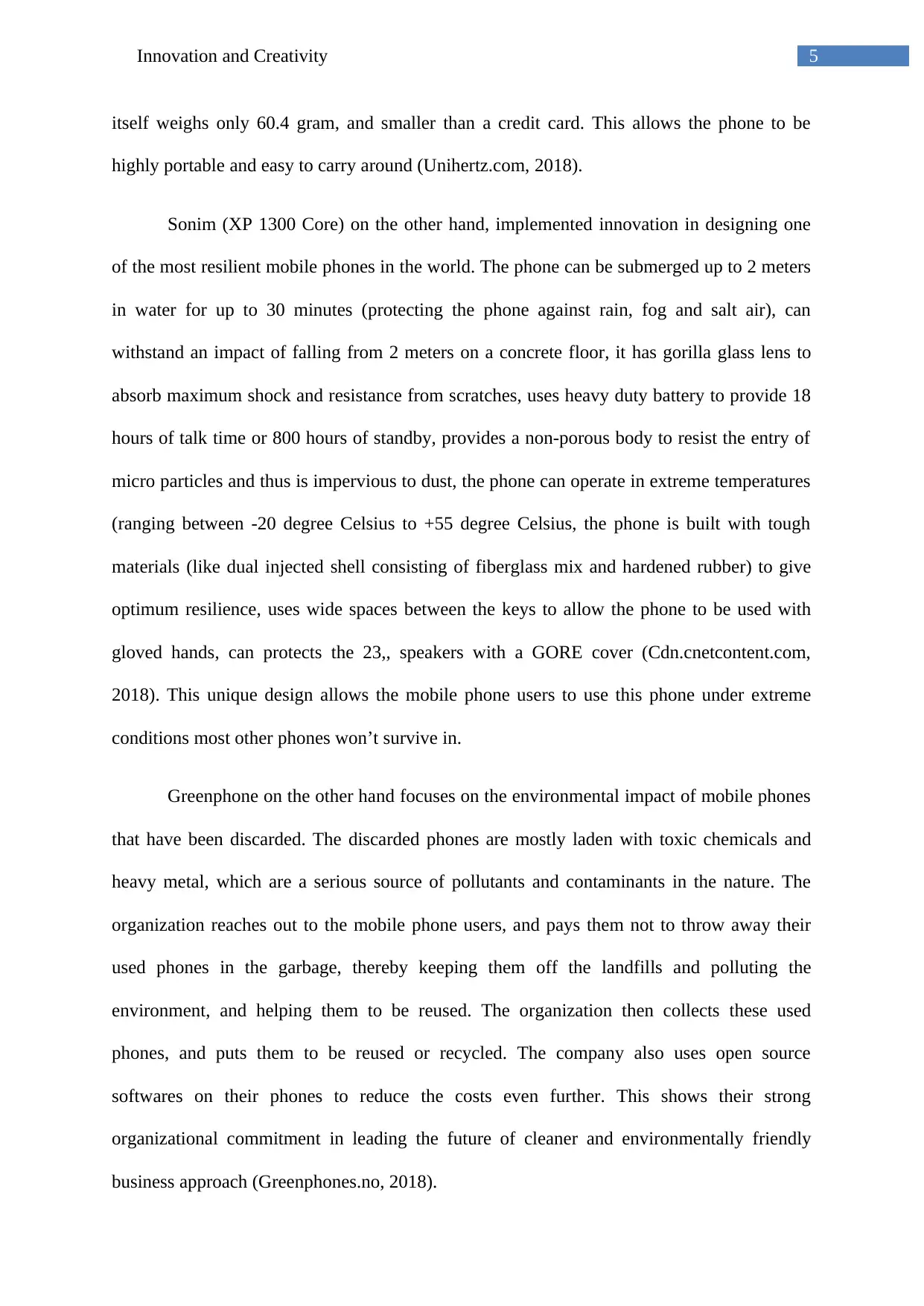
5Innovation and Creativity
itself weighs only 60.4 gram, and smaller than a credit card. This allows the phone to be
highly portable and easy to carry around (Unihertz.com, 2018).
Sonim (XP 1300 Core) on the other hand, implemented innovation in designing one
of the most resilient mobile phones in the world. The phone can be submerged up to 2 meters
in water for up to 30 minutes (protecting the phone against rain, fog and salt air), can
withstand an impact of falling from 2 meters on a concrete floor, it has gorilla glass lens to
absorb maximum shock and resistance from scratches, uses heavy duty battery to provide 18
hours of talk time or 800 hours of standby, provides a non-porous body to resist the entry of
micro particles and thus is impervious to dust, the phone can operate in extreme temperatures
(ranging between -20 degree Celsius to +55 degree Celsius, the phone is built with tough
materials (like dual injected shell consisting of fiberglass mix and hardened rubber) to give
optimum resilience, uses wide spaces between the keys to allow the phone to be used with
gloved hands, can protects the 23,, speakers with a GORE cover (Cdn.cnetcontent.com,
2018). This unique design allows the mobile phone users to use this phone under extreme
conditions most other phones won’t survive in.
Greenphone on the other hand focuses on the environmental impact of mobile phones
that have been discarded. The discarded phones are mostly laden with toxic chemicals and
heavy metal, which are a serious source of pollutants and contaminants in the nature. The
organization reaches out to the mobile phone users, and pays them not to throw away their
used phones in the garbage, thereby keeping them off the landfills and polluting the
environment, and helping them to be reused. The organization then collects these used
phones, and puts them to be reused or recycled. The company also uses open source
softwares on their phones to reduce the costs even further. This shows their strong
organizational commitment in leading the future of cleaner and environmentally friendly
business approach (Greenphones.no, 2018).
itself weighs only 60.4 gram, and smaller than a credit card. This allows the phone to be
highly portable and easy to carry around (Unihertz.com, 2018).
Sonim (XP 1300 Core) on the other hand, implemented innovation in designing one
of the most resilient mobile phones in the world. The phone can be submerged up to 2 meters
in water for up to 30 minutes (protecting the phone against rain, fog and salt air), can
withstand an impact of falling from 2 meters on a concrete floor, it has gorilla glass lens to
absorb maximum shock and resistance from scratches, uses heavy duty battery to provide 18
hours of talk time or 800 hours of standby, provides a non-porous body to resist the entry of
micro particles and thus is impervious to dust, the phone can operate in extreme temperatures
(ranging between -20 degree Celsius to +55 degree Celsius, the phone is built with tough
materials (like dual injected shell consisting of fiberglass mix and hardened rubber) to give
optimum resilience, uses wide spaces between the keys to allow the phone to be used with
gloved hands, can protects the 23,, speakers with a GORE cover (Cdn.cnetcontent.com,
2018). This unique design allows the mobile phone users to use this phone under extreme
conditions most other phones won’t survive in.
Greenphone on the other hand focuses on the environmental impact of mobile phones
that have been discarded. The discarded phones are mostly laden with toxic chemicals and
heavy metal, which are a serious source of pollutants and contaminants in the nature. The
organization reaches out to the mobile phone users, and pays them not to throw away their
used phones in the garbage, thereby keeping them off the landfills and polluting the
environment, and helping them to be reused. The organization then collects these used
phones, and puts them to be reused or recycled. The company also uses open source
softwares on their phones to reduce the costs even further. This shows their strong
organizational commitment in leading the future of cleaner and environmentally friendly
business approach (Greenphones.no, 2018).
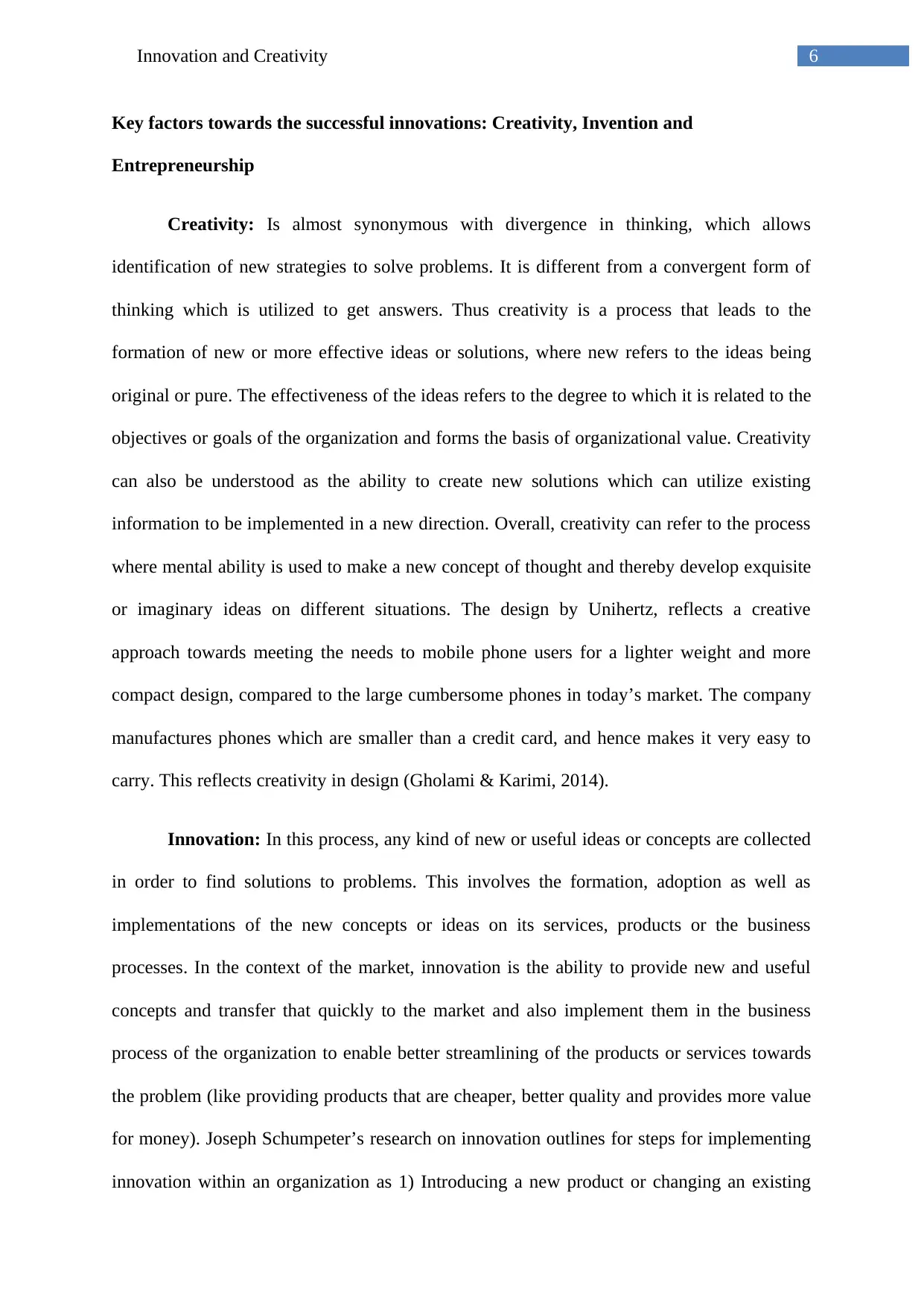
6Innovation and Creativity
Key factors towards the successful innovations: Creativity, Invention and
Entrepreneurship
Creativity: Is almost synonymous with divergence in thinking, which allows
identification of new strategies to solve problems. It is different from a convergent form of
thinking which is utilized to get answers. Thus creativity is a process that leads to the
formation of new or more effective ideas or solutions, where new refers to the ideas being
original or pure. The effectiveness of the ideas refers to the degree to which it is related to the
objectives or goals of the organization and forms the basis of organizational value. Creativity
can also be understood as the ability to create new solutions which can utilize existing
information to be implemented in a new direction. Overall, creativity can refer to the process
where mental ability is used to make a new concept of thought and thereby develop exquisite
or imaginary ideas on different situations. The design by Unihertz, reflects a creative
approach towards meeting the needs to mobile phone users for a lighter weight and more
compact design, compared to the large cumbersome phones in today’s market. The company
manufactures phones which are smaller than a credit card, and hence makes it very easy to
carry. This reflects creativity in design (Gholami & Karimi, 2014).
Innovation: In this process, any kind of new or useful ideas or concepts are collected
in order to find solutions to problems. This involves the formation, adoption as well as
implementations of the new concepts or ideas on its services, products or the business
processes. In the context of the market, innovation is the ability to provide new and useful
concepts and transfer that quickly to the market and also implement them in the business
process of the organization to enable better streamlining of the products or services towards
the problem (like providing products that are cheaper, better quality and provides more value
for money). Joseph Schumpeter’s research on innovation outlines for steps for implementing
innovation within an organization as 1) Introducing a new product or changing an existing
Key factors towards the successful innovations: Creativity, Invention and
Entrepreneurship
Creativity: Is almost synonymous with divergence in thinking, which allows
identification of new strategies to solve problems. It is different from a convergent form of
thinking which is utilized to get answers. Thus creativity is a process that leads to the
formation of new or more effective ideas or solutions, where new refers to the ideas being
original or pure. The effectiveness of the ideas refers to the degree to which it is related to the
objectives or goals of the organization and forms the basis of organizational value. Creativity
can also be understood as the ability to create new solutions which can utilize existing
information to be implemented in a new direction. Overall, creativity can refer to the process
where mental ability is used to make a new concept of thought and thereby develop exquisite
or imaginary ideas on different situations. The design by Unihertz, reflects a creative
approach towards meeting the needs to mobile phone users for a lighter weight and more
compact design, compared to the large cumbersome phones in today’s market. The company
manufactures phones which are smaller than a credit card, and hence makes it very easy to
carry. This reflects creativity in design (Gholami & Karimi, 2014).
Innovation: In this process, any kind of new or useful ideas or concepts are collected
in order to find solutions to problems. This involves the formation, adoption as well as
implementations of the new concepts or ideas on its services, products or the business
processes. In the context of the market, innovation is the ability to provide new and useful
concepts and transfer that quickly to the market and also implement them in the business
process of the organization to enable better streamlining of the products or services towards
the problem (like providing products that are cheaper, better quality and provides more value
for money). Joseph Schumpeter’s research on innovation outlines for steps for implementing
innovation within an organization as 1) Introducing a new product or changing an existing
Paraphrase This Document
Need a fresh take? Get an instant paraphrase of this document with our AI Paraphraser
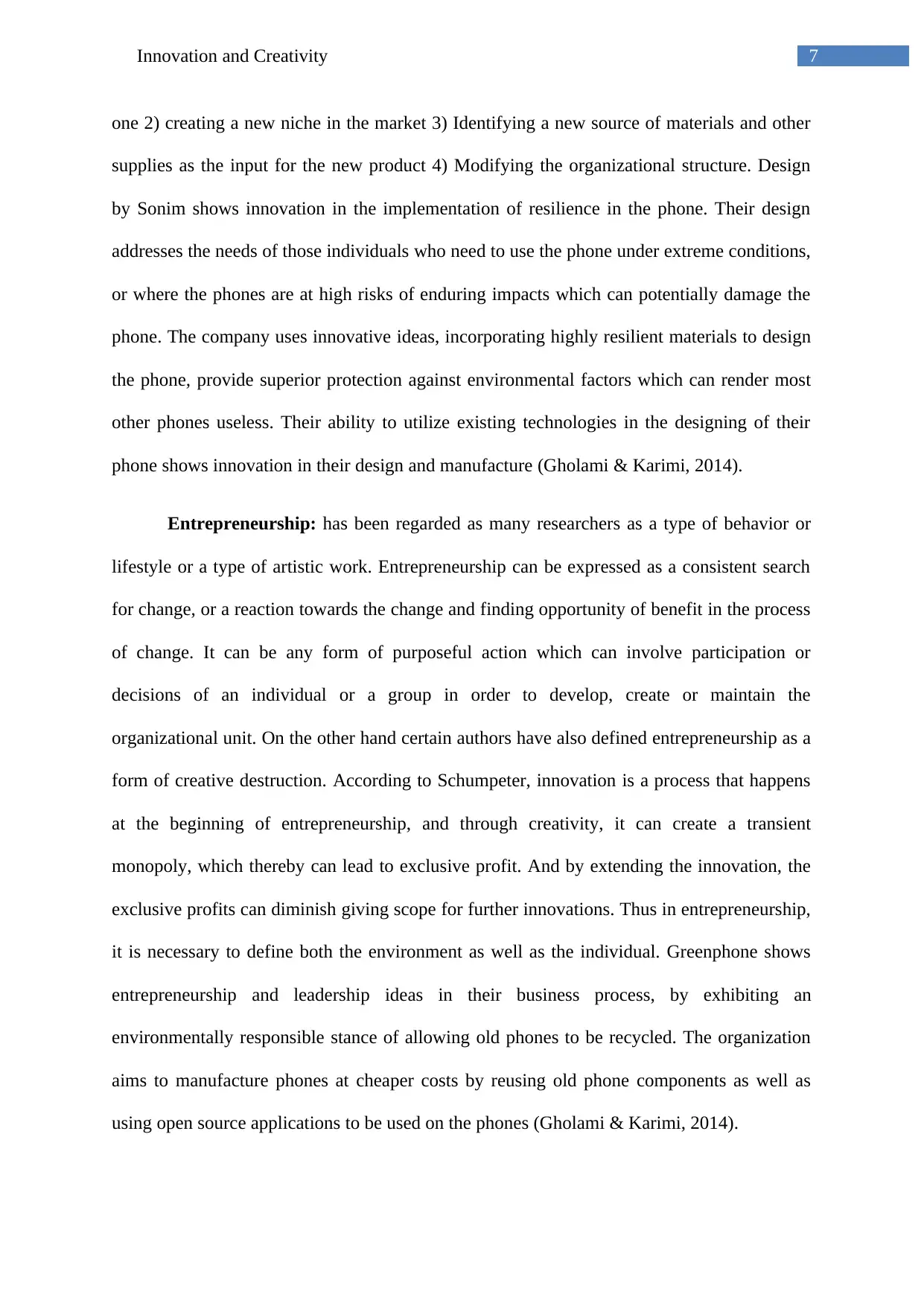
7Innovation and Creativity
one 2) creating a new niche in the market 3) Identifying a new source of materials and other
supplies as the input for the new product 4) Modifying the organizational structure. Design
by Sonim shows innovation in the implementation of resilience in the phone. Their design
addresses the needs of those individuals who need to use the phone under extreme conditions,
or where the phones are at high risks of enduring impacts which can potentially damage the
phone. The company uses innovative ideas, incorporating highly resilient materials to design
the phone, provide superior protection against environmental factors which can render most
other phones useless. Their ability to utilize existing technologies in the designing of their
phone shows innovation in their design and manufacture (Gholami & Karimi, 2014).
Entrepreneurship: has been regarded as many researchers as a type of behavior or
lifestyle or a type of artistic work. Entrepreneurship can be expressed as a consistent search
for change, or a reaction towards the change and finding opportunity of benefit in the process
of change. It can be any form of purposeful action which can involve participation or
decisions of an individual or a group in order to develop, create or maintain the
organizational unit. On the other hand certain authors have also defined entrepreneurship as a
form of creative destruction. According to Schumpeter, innovation is a process that happens
at the beginning of entrepreneurship, and through creativity, it can create a transient
monopoly, which thereby can lead to exclusive profit. And by extending the innovation, the
exclusive profits can diminish giving scope for further innovations. Thus in entrepreneurship,
it is necessary to define both the environment as well as the individual. Greenphone shows
entrepreneurship and leadership ideas in their business process, by exhibiting an
environmentally responsible stance of allowing old phones to be recycled. The organization
aims to manufacture phones at cheaper costs by reusing old phone components as well as
using open source applications to be used on the phones (Gholami & Karimi, 2014).
one 2) creating a new niche in the market 3) Identifying a new source of materials and other
supplies as the input for the new product 4) Modifying the organizational structure. Design
by Sonim shows innovation in the implementation of resilience in the phone. Their design
addresses the needs of those individuals who need to use the phone under extreme conditions,
or where the phones are at high risks of enduring impacts which can potentially damage the
phone. The company uses innovative ideas, incorporating highly resilient materials to design
the phone, provide superior protection against environmental factors which can render most
other phones useless. Their ability to utilize existing technologies in the designing of their
phone shows innovation in their design and manufacture (Gholami & Karimi, 2014).
Entrepreneurship: has been regarded as many researchers as a type of behavior or
lifestyle or a type of artistic work. Entrepreneurship can be expressed as a consistent search
for change, or a reaction towards the change and finding opportunity of benefit in the process
of change. It can be any form of purposeful action which can involve participation or
decisions of an individual or a group in order to develop, create or maintain the
organizational unit. On the other hand certain authors have also defined entrepreneurship as a
form of creative destruction. According to Schumpeter, innovation is a process that happens
at the beginning of entrepreneurship, and through creativity, it can create a transient
monopoly, which thereby can lead to exclusive profit. And by extending the innovation, the
exclusive profits can diminish giving scope for further innovations. Thus in entrepreneurship,
it is necessary to define both the environment as well as the individual. Greenphone shows
entrepreneurship and leadership ideas in their business process, by exhibiting an
environmentally responsible stance of allowing old phones to be recycled. The organization
aims to manufacture phones at cheaper costs by reusing old phone components as well as
using open source applications to be used on the phones (Gholami & Karimi, 2014).
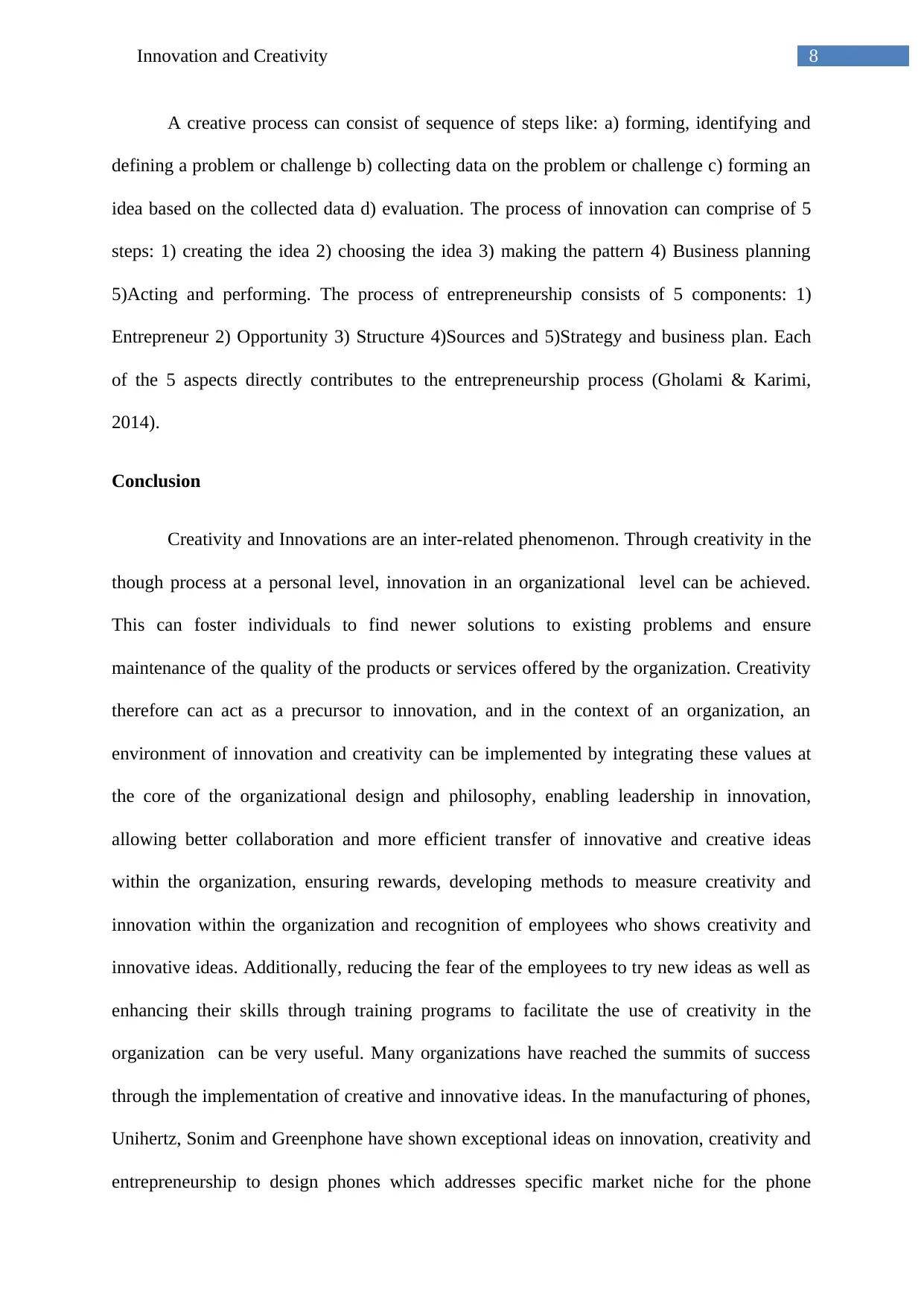
8Innovation and Creativity
A creative process can consist of sequence of steps like: a) forming, identifying and
defining a problem or challenge b) collecting data on the problem or challenge c) forming an
idea based on the collected data d) evaluation. The process of innovation can comprise of 5
steps: 1) creating the idea 2) choosing the idea 3) making the pattern 4) Business planning
5)Acting and performing. The process of entrepreneurship consists of 5 components: 1)
Entrepreneur 2) Opportunity 3) Structure 4)Sources and 5)Strategy and business plan. Each
of the 5 aspects directly contributes to the entrepreneurship process (Gholami & Karimi,
2014).
Conclusion
Creativity and Innovations are an inter-related phenomenon. Through creativity in the
though process at a personal level, innovation in an organizational level can be achieved.
This can foster individuals to find newer solutions to existing problems and ensure
maintenance of the quality of the products or services offered by the organization. Creativity
therefore can act as a precursor to innovation, and in the context of an organization, an
environment of innovation and creativity can be implemented by integrating these values at
the core of the organizational design and philosophy, enabling leadership in innovation,
allowing better collaboration and more efficient transfer of innovative and creative ideas
within the organization, ensuring rewards, developing methods to measure creativity and
innovation within the organization and recognition of employees who shows creativity and
innovative ideas. Additionally, reducing the fear of the employees to try new ideas as well as
enhancing their skills through training programs to facilitate the use of creativity in the
organization can be very useful. Many organizations have reached the summits of success
through the implementation of creative and innovative ideas. In the manufacturing of phones,
Unihertz, Sonim and Greenphone have shown exceptional ideas on innovation, creativity and
entrepreneurship to design phones which addresses specific market niche for the phone
A creative process can consist of sequence of steps like: a) forming, identifying and
defining a problem or challenge b) collecting data on the problem or challenge c) forming an
idea based on the collected data d) evaluation. The process of innovation can comprise of 5
steps: 1) creating the idea 2) choosing the idea 3) making the pattern 4) Business planning
5)Acting and performing. The process of entrepreneurship consists of 5 components: 1)
Entrepreneur 2) Opportunity 3) Structure 4)Sources and 5)Strategy and business plan. Each
of the 5 aspects directly contributes to the entrepreneurship process (Gholami & Karimi,
2014).
Conclusion
Creativity and Innovations are an inter-related phenomenon. Through creativity in the
though process at a personal level, innovation in an organizational level can be achieved.
This can foster individuals to find newer solutions to existing problems and ensure
maintenance of the quality of the products or services offered by the organization. Creativity
therefore can act as a precursor to innovation, and in the context of an organization, an
environment of innovation and creativity can be implemented by integrating these values at
the core of the organizational design and philosophy, enabling leadership in innovation,
allowing better collaboration and more efficient transfer of innovative and creative ideas
within the organization, ensuring rewards, developing methods to measure creativity and
innovation within the organization and recognition of employees who shows creativity and
innovative ideas. Additionally, reducing the fear of the employees to try new ideas as well as
enhancing their skills through training programs to facilitate the use of creativity in the
organization can be very useful. Many organizations have reached the summits of success
through the implementation of creative and innovative ideas. In the manufacturing of phones,
Unihertz, Sonim and Greenphone have shown exceptional ideas on innovation, creativity and
entrepreneurship to design phones which addresses specific market niche for the phone
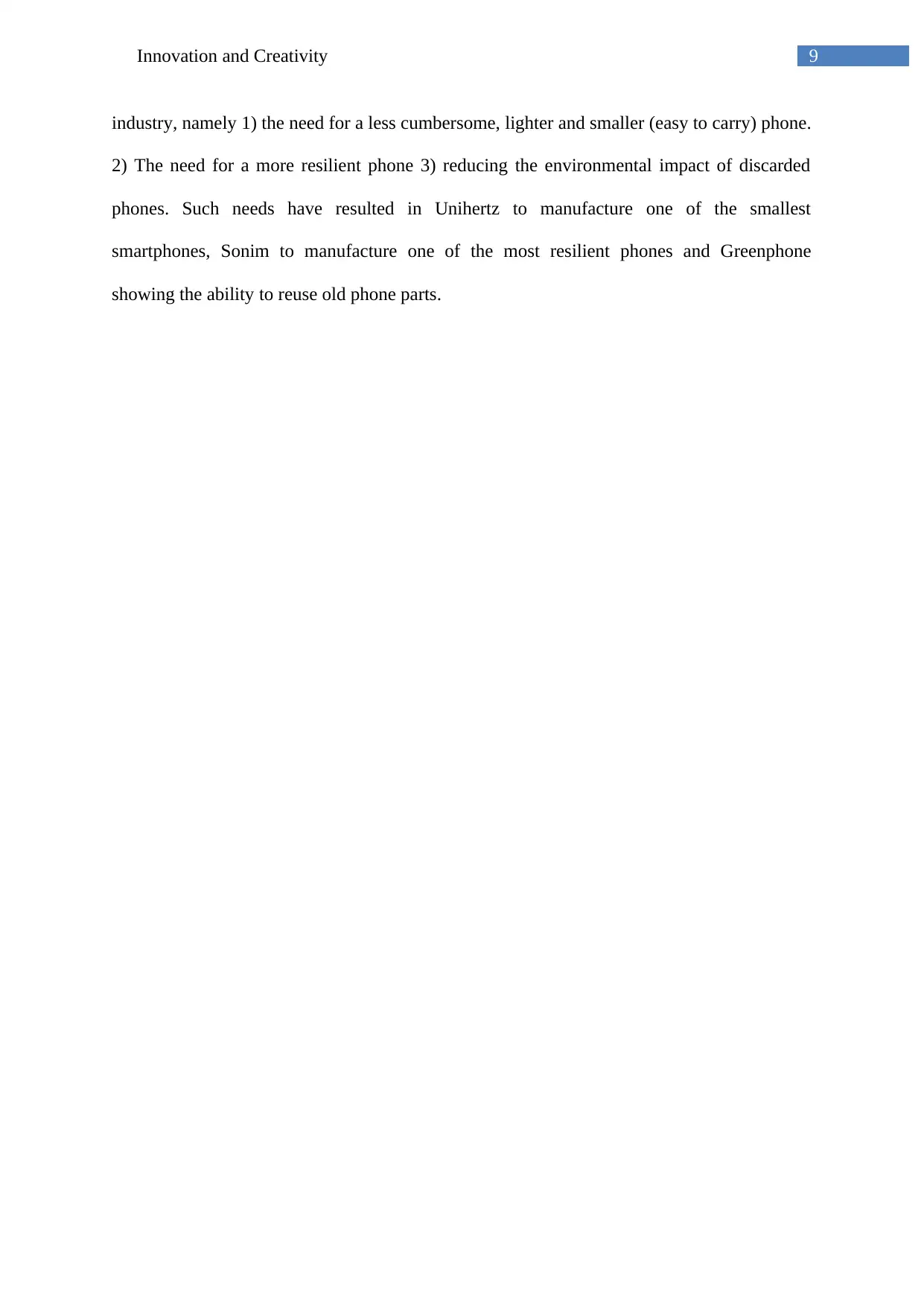
9Innovation and Creativity
industry, namely 1) the need for a less cumbersome, lighter and smaller (easy to carry) phone.
2) The need for a more resilient phone 3) reducing the environmental impact of discarded
phones. Such needs have resulted in Unihertz to manufacture one of the smallest
smartphones, Sonim to manufacture one of the most resilient phones and Greenphone
showing the ability to reuse old phone parts.
industry, namely 1) the need for a less cumbersome, lighter and smaller (easy to carry) phone.
2) The need for a more resilient phone 3) reducing the environmental impact of discarded
phones. Such needs have resulted in Unihertz to manufacture one of the smallest
smartphones, Sonim to manufacture one of the most resilient phones and Greenphone
showing the ability to reuse old phone parts.
Secure Best Marks with AI Grader
Need help grading? Try our AI Grader for instant feedback on your assignments.
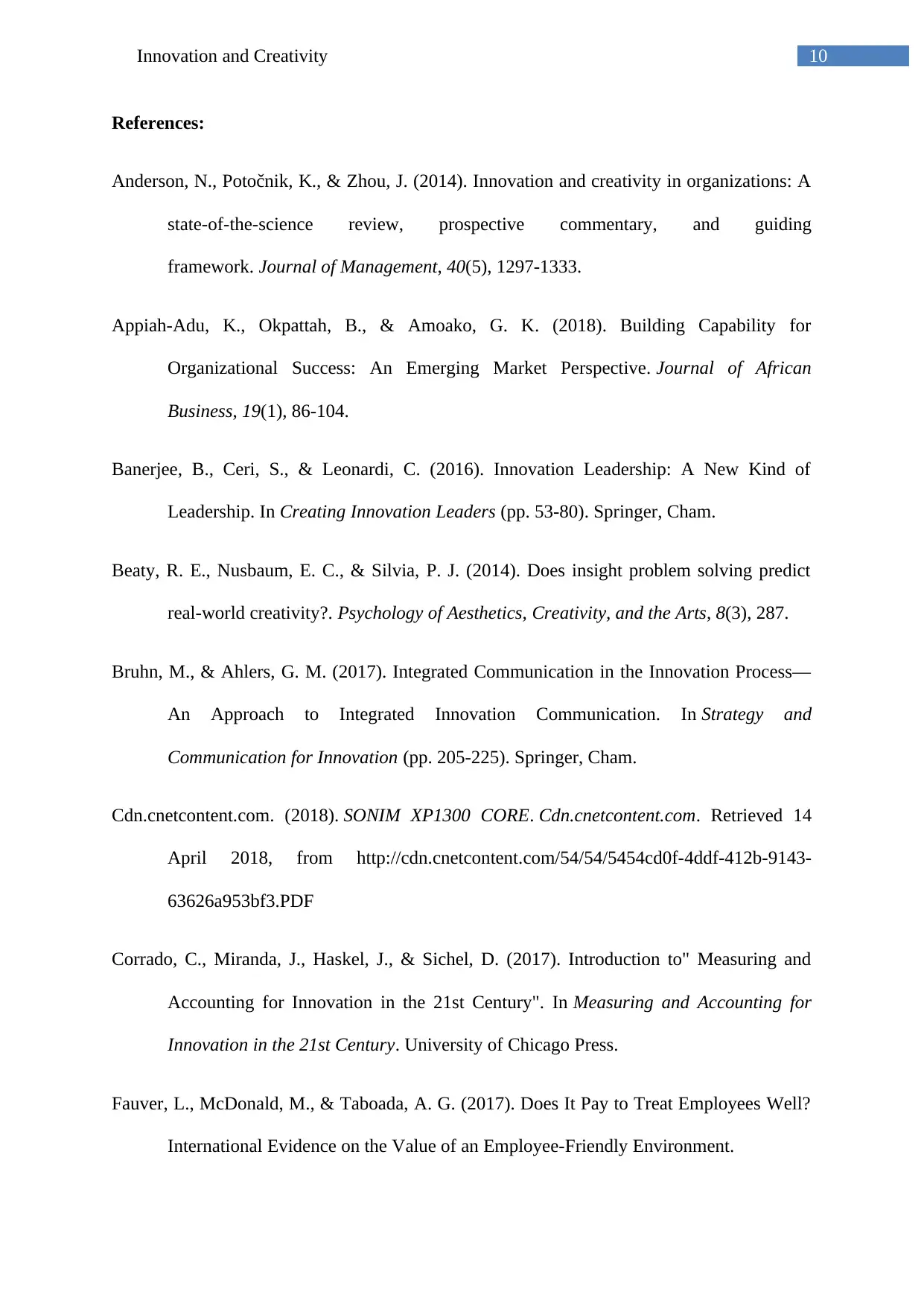
10Innovation and Creativity
References:
Anderson, N., Potočnik, K., & Zhou, J. (2014). Innovation and creativity in organizations: A
state-of-the-science review, prospective commentary, and guiding
framework. Journal of Management, 40(5), 1297-1333.
Appiah-Adu, K., Okpattah, B., & Amoako, G. K. (2018). Building Capability for
Organizational Success: An Emerging Market Perspective. Journal of African
Business, 19(1), 86-104.
Banerjee, B., Ceri, S., & Leonardi, C. (2016). Innovation Leadership: A New Kind of
Leadership. In Creating Innovation Leaders (pp. 53-80). Springer, Cham.
Beaty, R. E., Nusbaum, E. C., & Silvia, P. J. (2014). Does insight problem solving predict
real-world creativity?. Psychology of Aesthetics, Creativity, and the Arts, 8(3), 287.
Bruhn, M., & Ahlers, G. M. (2017). Integrated Communication in the Innovation Process—
An Approach to Integrated Innovation Communication. In Strategy and
Communication for Innovation (pp. 205-225). Springer, Cham.
Cdn.cnetcontent.com. (2018). SONIM XP1300 CORE. Cdn.cnetcontent.com. Retrieved 14
April 2018, from http://cdn.cnetcontent.com/54/54/5454cd0f-4ddf-412b-9143-
63626a953bf3.PDF
Corrado, C., Miranda, J., Haskel, J., & Sichel, D. (2017). Introduction to" Measuring and
Accounting for Innovation in the 21st Century". In Measuring and Accounting for
Innovation in the 21st Century. University of Chicago Press.
Fauver, L., McDonald, M., & Taboada, A. G. (2017). Does It Pay to Treat Employees Well?
International Evidence on the Value of an Employee-Friendly Environment.
References:
Anderson, N., Potočnik, K., & Zhou, J. (2014). Innovation and creativity in organizations: A
state-of-the-science review, prospective commentary, and guiding
framework. Journal of Management, 40(5), 1297-1333.
Appiah-Adu, K., Okpattah, B., & Amoako, G. K. (2018). Building Capability for
Organizational Success: An Emerging Market Perspective. Journal of African
Business, 19(1), 86-104.
Banerjee, B., Ceri, S., & Leonardi, C. (2016). Innovation Leadership: A New Kind of
Leadership. In Creating Innovation Leaders (pp. 53-80). Springer, Cham.
Beaty, R. E., Nusbaum, E. C., & Silvia, P. J. (2014). Does insight problem solving predict
real-world creativity?. Psychology of Aesthetics, Creativity, and the Arts, 8(3), 287.
Bruhn, M., & Ahlers, G. M. (2017). Integrated Communication in the Innovation Process—
An Approach to Integrated Innovation Communication. In Strategy and
Communication for Innovation (pp. 205-225). Springer, Cham.
Cdn.cnetcontent.com. (2018). SONIM XP1300 CORE. Cdn.cnetcontent.com. Retrieved 14
April 2018, from http://cdn.cnetcontent.com/54/54/5454cd0f-4ddf-412b-9143-
63626a953bf3.PDF
Corrado, C., Miranda, J., Haskel, J., & Sichel, D. (2017). Introduction to" Measuring and
Accounting for Innovation in the 21st Century". In Measuring and Accounting for
Innovation in the 21st Century. University of Chicago Press.
Fauver, L., McDonald, M., & Taboada, A. G. (2017). Does It Pay to Treat Employees Well?
International Evidence on the Value of an Employee-Friendly Environment.
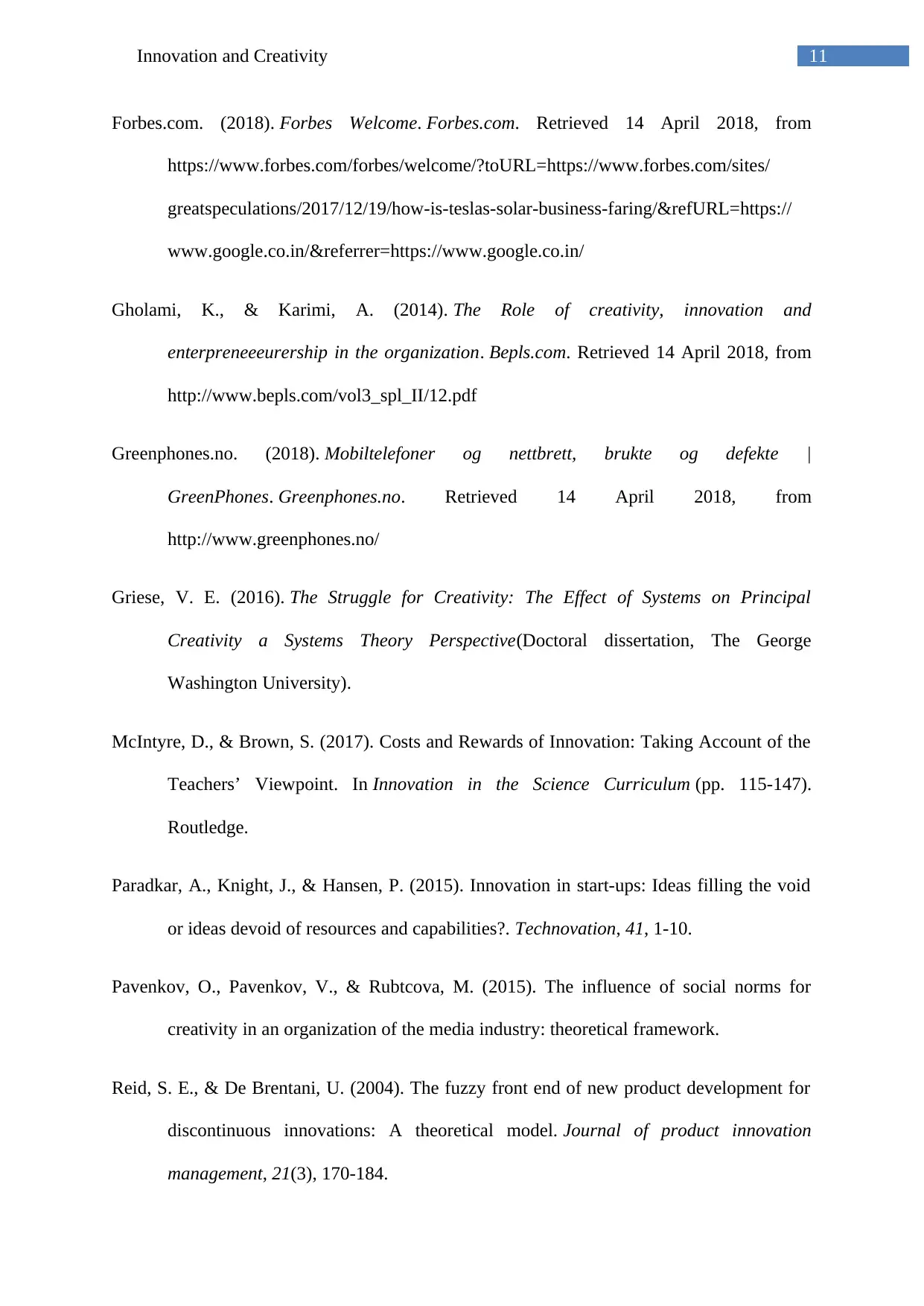
11Innovation and Creativity
Forbes.com. (2018). Forbes Welcome. Forbes.com. Retrieved 14 April 2018, from
https://www.forbes.com/forbes/welcome/?toURL=https://www.forbes.com/sites/
greatspeculations/2017/12/19/how-is-teslas-solar-business-faring/&refURL=https://
www.google.co.in/&referrer=https://www.google.co.in/
Gholami, K., & Karimi, A. (2014). The Role of creativity, innovation and
enterpreneeeurership in the organization. Bepls.com. Retrieved 14 April 2018, from
http://www.bepls.com/vol3_spl_II/12.pdf
Greenphones.no. (2018). Mobiltelefoner og nettbrett, brukte og defekte |
GreenPhones. Greenphones.no. Retrieved 14 April 2018, from
http://www.greenphones.no/
Griese, V. E. (2016). The Struggle for Creativity: The Effect of Systems on Principal
Creativity a Systems Theory Perspective(Doctoral dissertation, The George
Washington University).
McIntyre, D., & Brown, S. (2017). Costs and Rewards of Innovation: Taking Account of the
Teachers’ Viewpoint. In Innovation in the Science Curriculum (pp. 115-147).
Routledge.
Paradkar, A., Knight, J., & Hansen, P. (2015). Innovation in start-ups: Ideas filling the void
or ideas devoid of resources and capabilities?. Technovation, 41, 1-10.
Pavenkov, O., Pavenkov, V., & Rubtcova, M. (2015). The influence of social norms for
creativity in an organization of the media industry: theoretical framework.
Reid, S. E., & De Brentani, U. (2004). The fuzzy front end of new product development for
discontinuous innovations: A theoretical model. Journal of product innovation
management, 21(3), 170-184.
Forbes.com. (2018). Forbes Welcome. Forbes.com. Retrieved 14 April 2018, from
https://www.forbes.com/forbes/welcome/?toURL=https://www.forbes.com/sites/
greatspeculations/2017/12/19/how-is-teslas-solar-business-faring/&refURL=https://
www.google.co.in/&referrer=https://www.google.co.in/
Gholami, K., & Karimi, A. (2014). The Role of creativity, innovation and
enterpreneeeurership in the organization. Bepls.com. Retrieved 14 April 2018, from
http://www.bepls.com/vol3_spl_II/12.pdf
Greenphones.no. (2018). Mobiltelefoner og nettbrett, brukte og defekte |
GreenPhones. Greenphones.no. Retrieved 14 April 2018, from
http://www.greenphones.no/
Griese, V. E. (2016). The Struggle for Creativity: The Effect of Systems on Principal
Creativity a Systems Theory Perspective(Doctoral dissertation, The George
Washington University).
McIntyre, D., & Brown, S. (2017). Costs and Rewards of Innovation: Taking Account of the
Teachers’ Viewpoint. In Innovation in the Science Curriculum (pp. 115-147).
Routledge.
Paradkar, A., Knight, J., & Hansen, P. (2015). Innovation in start-ups: Ideas filling the void
or ideas devoid of resources and capabilities?. Technovation, 41, 1-10.
Pavenkov, O., Pavenkov, V., & Rubtcova, M. (2015). The influence of social norms for
creativity in an organization of the media industry: theoretical framework.
Reid, S. E., & De Brentani, U. (2004). The fuzzy front end of new product development for
discontinuous innovations: A theoretical model. Journal of product innovation
management, 21(3), 170-184.

12Innovation and Creativity
Reis, D., & Hunt, B. (2016, December). Training Businesspeople in Structured Innovation:
Uncovering the Innovation Learner's Experience. In ISPIM Innovation Symposium (p.
1). The International Society for Professional Innovation Management (ISPIM).
Unihertz.com. (2018). JELLY - Unihertz. Unihertz.com. Retrieved 14 April 2018, from
https://www.unihertz.com/jelly.html
van Tilburg, W. A., Sedikides, C., & Wildschut, T. (2015). The mnemonic muse: Nostalgia
fosters creativity through openness to experience. Journal of Experimental Social
Psychology, 59, 1-7.
Wirtz, B. W., Pistoia, A., Ullrich, S., & Göttel, V. (2016). Business models: Origin,
development and future research perspectives. Long Range Planning, 49(1), 36-54.
Reis, D., & Hunt, B. (2016, December). Training Businesspeople in Structured Innovation:
Uncovering the Innovation Learner's Experience. In ISPIM Innovation Symposium (p.
1). The International Society for Professional Innovation Management (ISPIM).
Unihertz.com. (2018). JELLY - Unihertz. Unihertz.com. Retrieved 14 April 2018, from
https://www.unihertz.com/jelly.html
van Tilburg, W. A., Sedikides, C., & Wildschut, T. (2015). The mnemonic muse: Nostalgia
fosters creativity through openness to experience. Journal of Experimental Social
Psychology, 59, 1-7.
Wirtz, B. W., Pistoia, A., Ullrich, S., & Göttel, V. (2016). Business models: Origin,
development and future research perspectives. Long Range Planning, 49(1), 36-54.
Paraphrase This Document
Need a fresh take? Get an instant paraphrase of this document with our AI Paraphraser

13Innovation and Creativity
1 out of 14
Related Documents
Your All-in-One AI-Powered Toolkit for Academic Success.
+13062052269
info@desklib.com
Available 24*7 on WhatsApp / Email
![[object Object]](/_next/static/media/star-bottom.7253800d.svg)
Unlock your academic potential
© 2024 | Zucol Services PVT LTD | All rights reserved.





